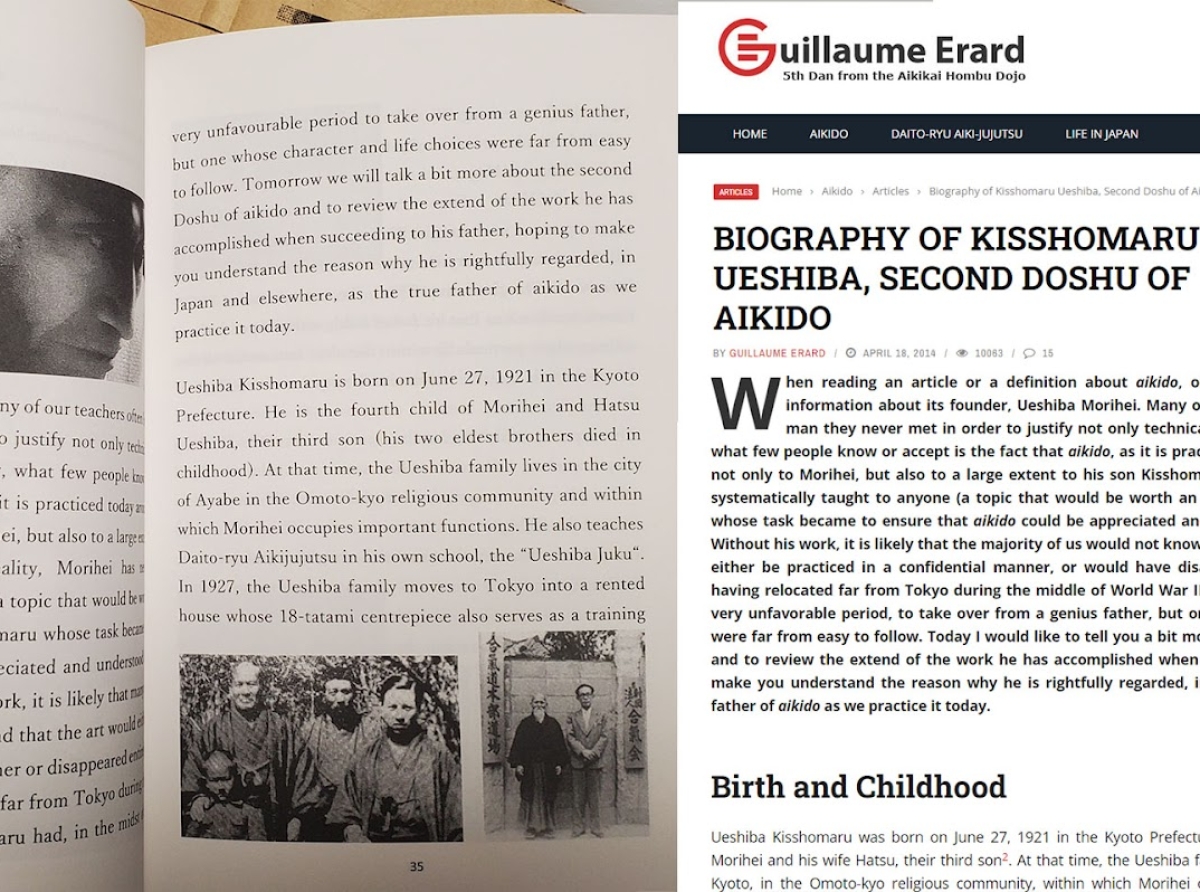The aim of this article is to provide a case study to hopefully inform the readers on how they can support the authors whose work they appreciate, and avoid providing undeserved exposure to content farms. Some time ago, one of my readers shared with me a post from a Facebook page that, he said, looked like it was reposting my articles without credit. I went to look at the page called “Aikido and Budo” and indeed, I found out that they were basically posting a large amount of Aikido content that was already available online, most of the time without giving any credit or context.
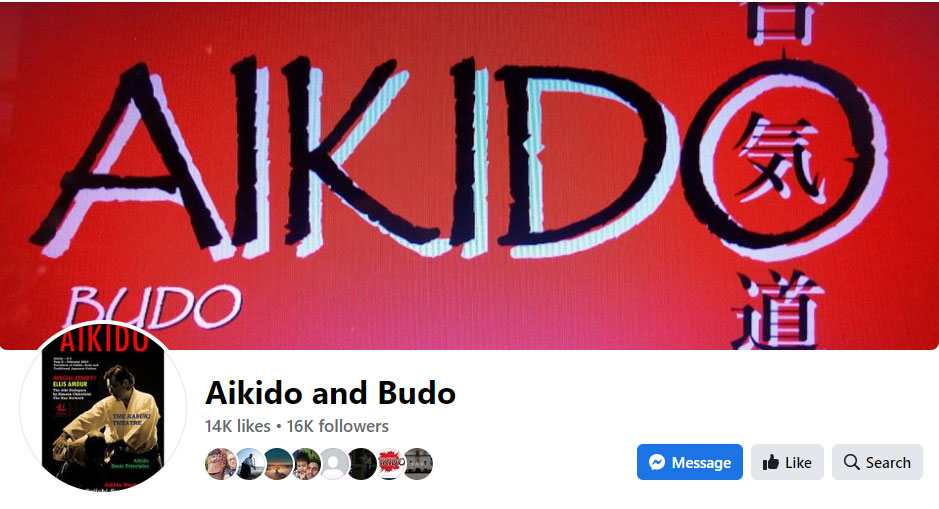 Aikido and Budo Facebook page. Sadly, many of my own friends seem to be following this page and therefore, enjoying my content, outside of my own website.
Aikido and Budo Facebook page. Sadly, many of my own friends seem to be following this page and therefore, enjoying my content, outside of my own website.
For example, I noticed that my biography of Ueshiba Kisshomaru was posted there, along with a number of other pieces I had written, such as most recently, my biography of Virginia Mayhew, or my interview with Tada Shihan.
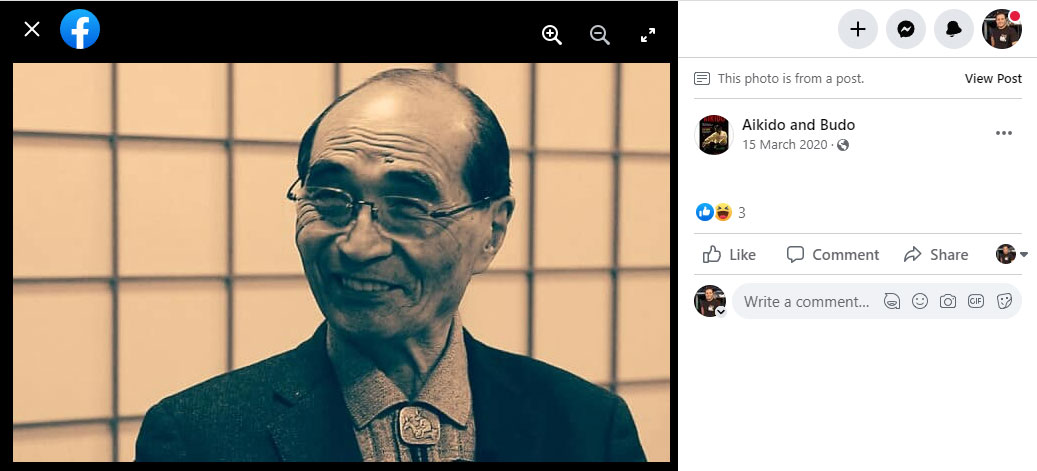 One of the numerous photos that the Aikido and Budo Facebook page is posting without authorization
One of the numerous photos that the Aikido and Budo Facebook page is posting without authorization
The page also reproduces a number of other contents including that of Aikido Journal. I confirmed with Aikido Journal Editor Josh Gold that no attempts had been made to seek approval before reposting this content.
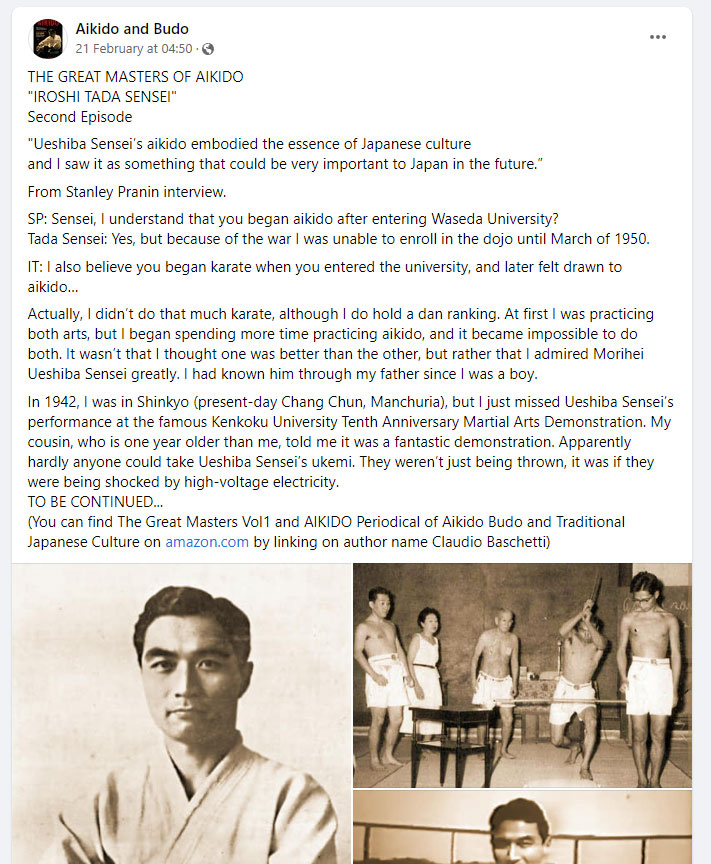 One of many posts that reproduce without authorization Aikido Journal contents (the original is available here). Note that citing the source does not entitle one to reproduce the content in its entirety like what is done here.
One of many posts that reproduce without authorization Aikido Journal contents (the original is available here). Note that citing the source does not entitle one to reproduce the content in its entirety like what is done here.
I also found contents that belong to the Japanese magazine I often contribute to: Gekkan Hiden. All materials published in Hiden are obviously copyrighted under Japanese law.
Several months ago, I commented on some of the posts on the Facebook page to object to this illegal use of my content but the administrators of the page deleted my message. I therefore issued complaints directly towards Facebook, who assessed that the content was indeed infringing my copyright and they took it down. Unfortunately, even though this led to the taking down of numerous posts, Facebook did not seem to have taken disciplinary action against the page itself.
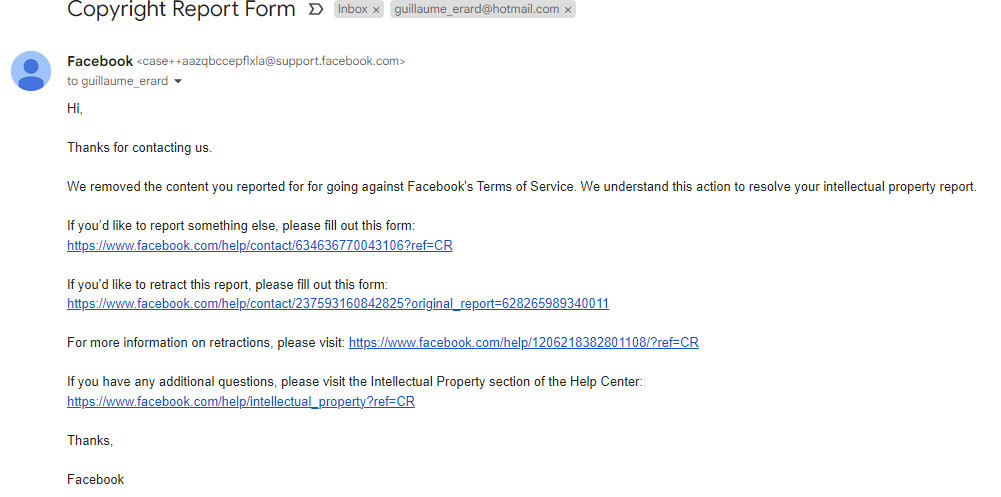 One of Facebook’s acknowledgement emails confirming that they removed my article on Virginia Mayhew from the “Aikido and Budo” page.
One of Facebook’s acknowledgement emails confirming that they removed my article on Virginia Mayhew from the “Aikido and Budo” page.
I pretty much forgot about it until one of my contacts published a post on Facebook that caught my attention. I realized that the page I had previosuly flagged was also promoting hard copy publications sold through Amazon.
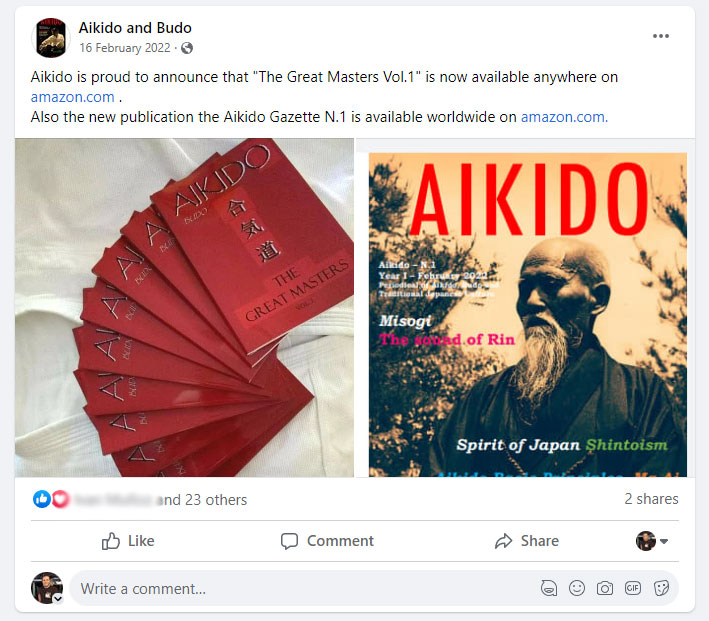
I got a hunch that those hard copies may well also have contained some of my material. I therefore bit the bullet and ordered the book called “Aikido , The Great Masters Vol.1: Budo”, sold for 1,516 Yen, about 11 dollars.
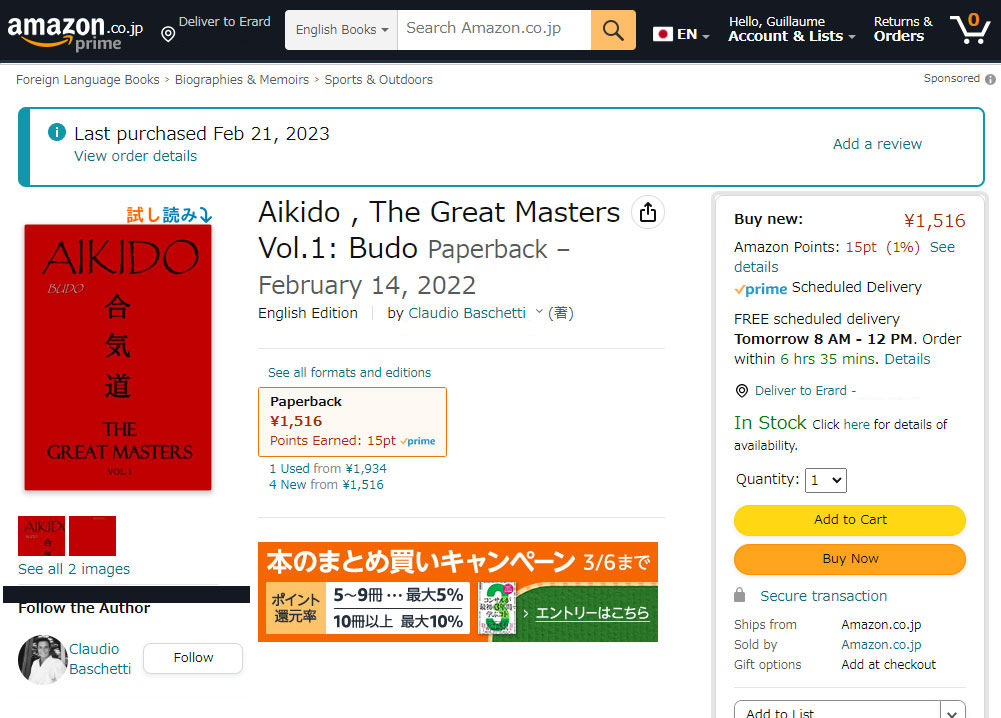 Product page of the book
Product page of the book
I received the book a few days later and unsurprisingly, I found that it did contain my biography of Ueshiba Kisshomaru, reproduced almost word for word.
Plagiarism check analysis
I went ahead and took some text samples throughout the books and ran them on a plagiarism check and associated text comparison software, which invariably returned hits to sources originally published on the Internet.
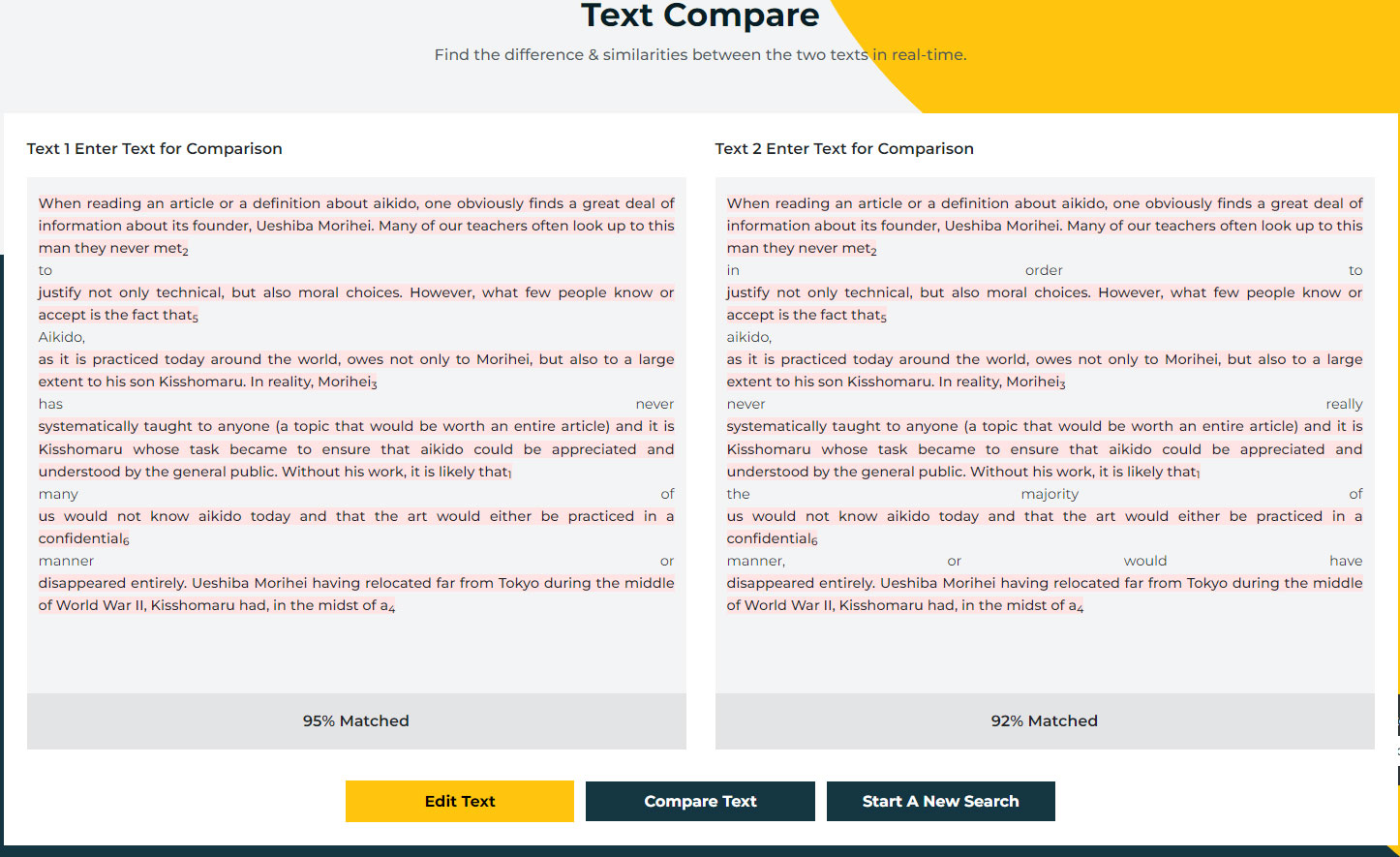 Result of comparison check on a sample page. It shows that for the sample I ran, there was a 95% word-for-word match between the content of the book and my article.
Result of comparison check on a sample page. It shows that for the sample I ran, there was a 95% word-for-word match between the content of the book and my article.
The data I collected demonstrates that this book sold for over 10 dollars contains mostly materials that was scraped off the Internet. Besides my own text, it contains articles initially published in French by a friend of mine called Nicolas De Araujo, and the majority of the rest is from Wikipedia. The table below shows the result of a sample analysis that I performed, with links to the original sources, including the percentage match word-for-word.
| Contents | Page sampled | Original author | Word for Word Match |
| Morihei Ueshiba | p. 11 | Wikipedia | 93% |
| Kisshomaru Ueshiba | p. 34 | Guillaume Erard | 95% |
| Koichi Tohei | p. 70 | Ki Research Institute | 90% |
| Morihiro Saito | p. 81 | Wikipedia | 94% |
| Tadashi Abe | p. 101 | Nicolas De Araujo | Translation |
| Seiseki Abe | p. 106 | Wikipedia | 66% |
| Yoshimitsu Yamada | p. 117 | Piotr Burnos & Marta Sobolska | 95% |
| Hirokazu Kobayashi | p. 139 | Wikipedia | 95% |
| Michio Hikitsuchi | p. 143 | Nicolas De Araujo | Translation |
| Masamichi Noro | p. 154 | Wikipedia | 91% |
Note that if we look at the inside of the book itself, a unique author is listed, which is consistent with what is written on the Amazon page. It also states that the contents of the book are copyrighted material.
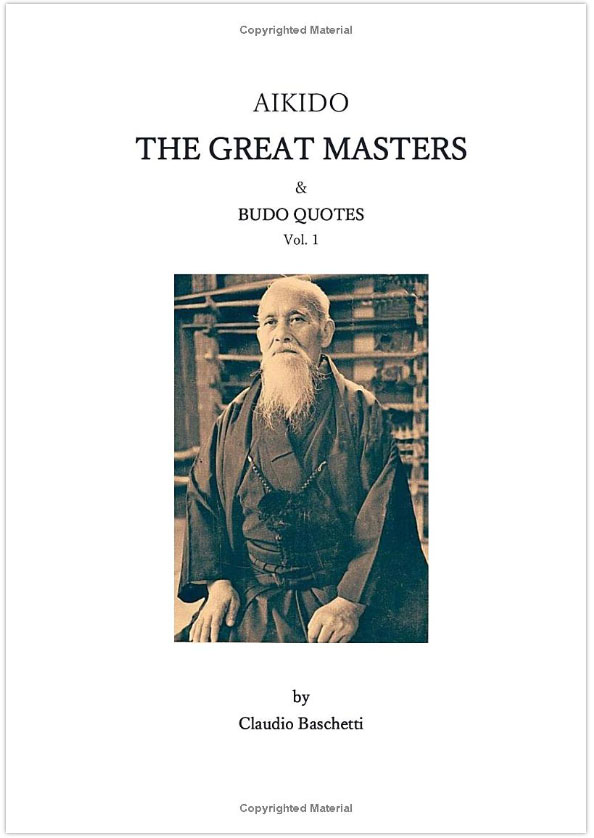 Page from the book showing that the material is copyrighted.
Page from the book showing that the material is copyrighted.
Nowhere to be seen on the Amazon page, but present towards the end of the book is the following, rather insufficient disclaimer (p. 174):
DisclaimerThis is not an unpublished literary work, but an anthology of texts and quotes extrapolated from various edited works. The content of this work it has been taken from the following sources :
a) Wikipedia The Free Encyclopedia
b) Budo, Teaching of the Founder by Morihei Ueshiba Copyright 1991 by Kodansha International Ltd
c) The Spirit of Aikido by Kisshomaru Ueshiba Copyright 1984 by Kisshomaru Ueshiba
Under standard copyright laws, which apply to both this book and the books Budo, Teaching of the Founder and The Spirit of Aikido, such a disclaimer does not allow one to reproduce any material without the explicit approval of the respective rights owners, let alone sell it commercially. More importantly, the disclaimer also fails to mention the origin of five out of the ten text samples that I have taken. In the case of a legitimate anthology, the author of the book would be credited as the editor, not the author, and he would have secured the appropriate authorization for use of each reproduced, and would most likely be paying royalties to their orginal authors. I can testify that this is not the case here.
What about Fair Use?
Fair Use is an American legal doctrine. According to the U.S. Copyright Office, Fair Use allows the unlicensed use of copyright-protected works under certain circumstances such as criticism, comment, news reporting, teaching, scholarship, and research. It is important to note that Fair Use is not applicable to all countries, for instance, such a doctrine does not explicitly exist in Japanese law. Either way, Fair Use is generally limited to brief excerpts of texts such as citations, or restricted numbers of images or videos excerpts.
As it happens, I was contacted recently by Japanese television channel TV Asahi as they wanted to use a very short excerpt of one of my videos for their テレビ朝日「Qさま!!」 show. Under Japanese law, they were obliged to do so, regardless of how short the excerpt was.
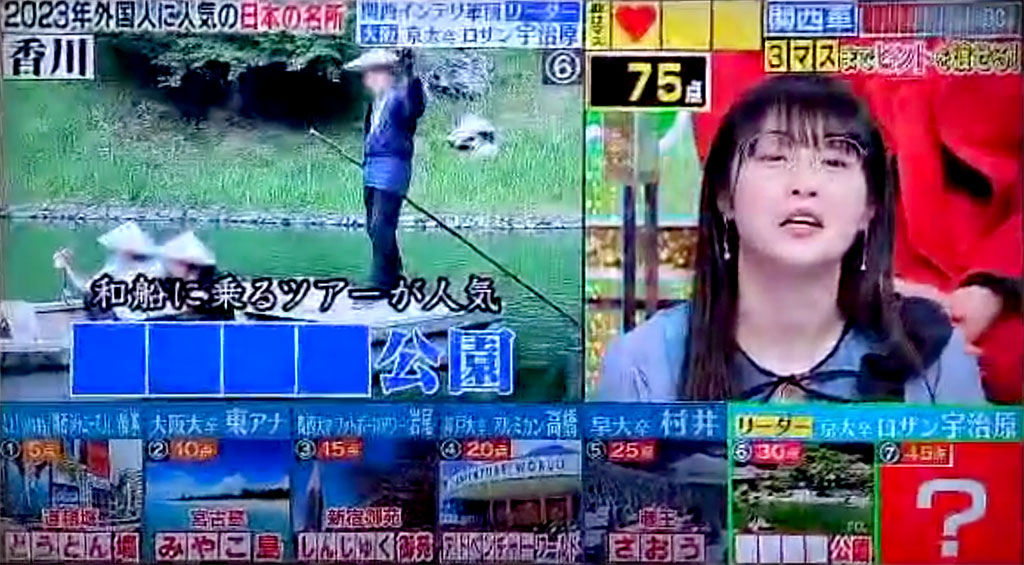 Asahi TV using an excerpt of my Ritsurin video for their TV show aired on February 28, 2023. As Japanese law requires, they contacted me ahead of time to obtain the rights to the excerpt.
Asahi TV using an excerpt of my Ritsurin video for their TV show aired on February 28, 2023. As Japanese law requires, they contacted me ahead of time to obtain the rights to the excerpt.
My work
Personally, I try to restrict my publications to the materials that I have produced myself, but when other materials are absolutely necessary, I make sure to secure the authorization prior to use. Most of my sources come from Aikido Journal and the Aikikai publications, and I am in frequent communication with both entities, who are aware of my work and thankfully, appreciate its value. Generally, I would not want to have to defend my use of third party material on legal grounds so I try as much as I can not to resort to Fair Use, even when I could legitimately do so.
On the other hand, in the case of the book mentioned here, reproducing entire texts or images as is (the high homology scores suggest that very little editing was done), without comment, analysis, or any other added value, cannot legitimately be clasified under Fair Use.
A quick side-by-side comparison between the text of the book and that which is published on my website will leave no doubt about its origin. The content is copied word for word.
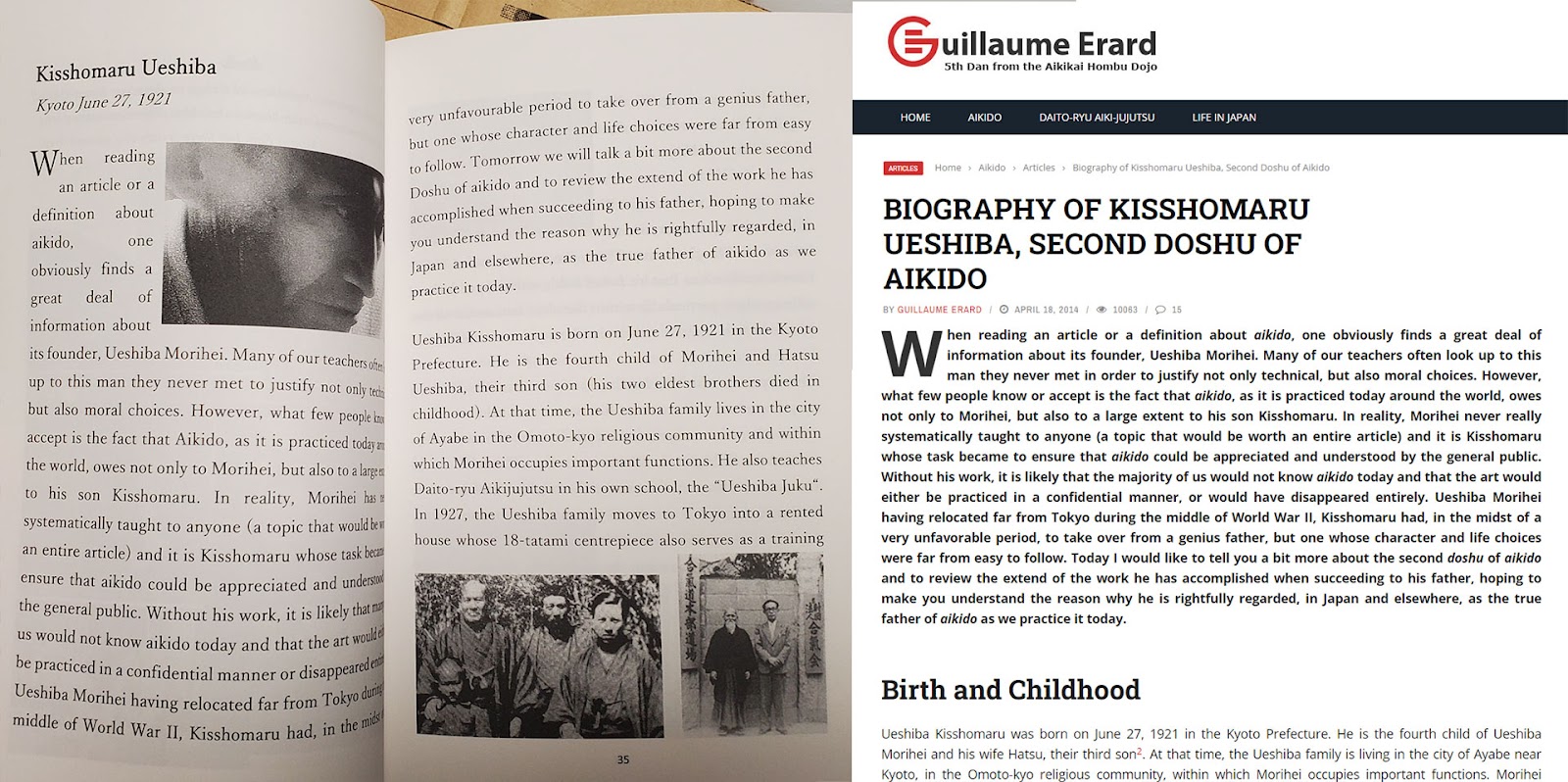 Plagiarized text in the dubious book (left) and the original version on my website (right).
Plagiarized text in the dubious book (left) and the original version on my website (right).
Note that my article was initially published in French in the magazine Dragon, in 2014, 8 years before the problematic book was published. The English version was published at the same time on my website and it has received very positive feedback, including from the Aikikai itself.
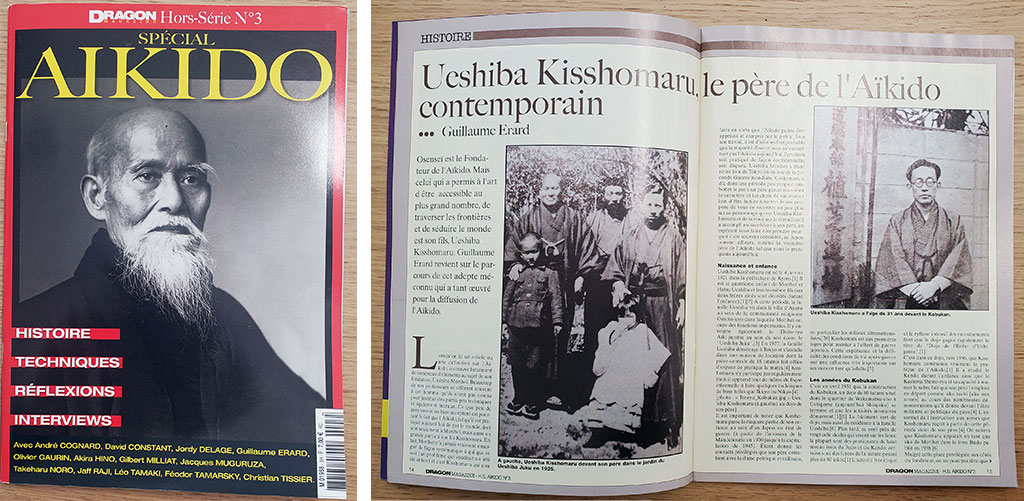 Original article published in French in Dragon Magazine in January 2014.
Original article published in French in Dragon Magazine in January 2014.
The piece was minimally laterned in the book as it was initially reproduced without my permission in several installments on the Aikido and Budo Facebook page (which I got Facebook to take down). The version that was committed to hard copy still bears the hallmarks of this editing. For example, my website article originally states:
Today I would like to tell you a bit more about the second doshu of aikido and to review the extent of the work he has accomplished when succeeding to his father, hoping to make you understand the reason why he is rightfully regarded, in Japan and elsewhere, as the true father of aikido as we practice it today.
In the book, it was pasted as is from the Facebook page copy, which now make no sense at all in the context of a book.
Tomorrow we will talk a bit more about the second Doshu of aikido and to review the extend of the work he has accomplished when succeeding to his father, hoping to make you understand the reason why he is rightfully regarded, in Japan and elsewhere, as the true father of aikido as we practice it today.
Wikipedia contents
Wikipedia articles are published under Creative Commons Attribution-ShareAlike (CC-BY-SA), which means that anyone is free to copy and redistribute them, even commercially. However, one must:
- give appropriate credit, provide a link to the license, and indicate if changes were made
- not apply legal terms or technological measures that legally restrict others from doing anything the license permits
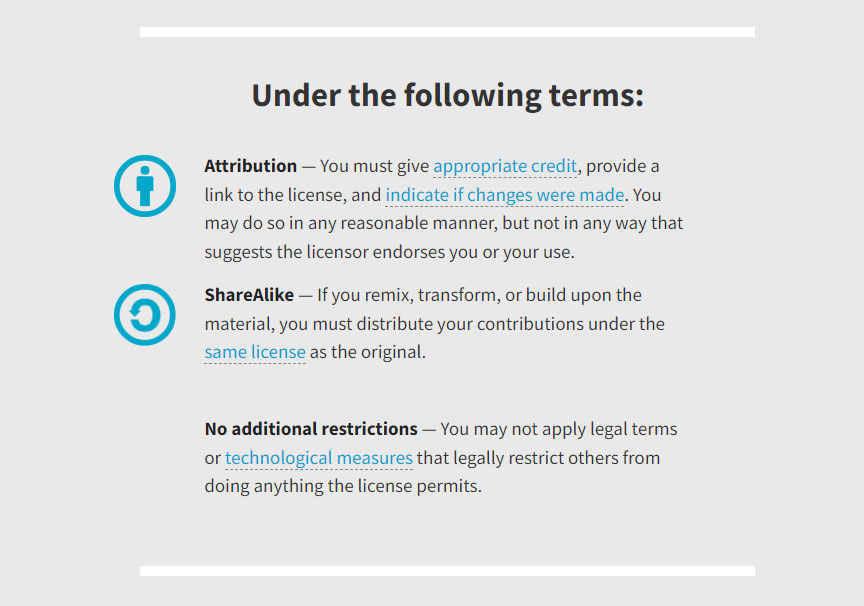 Summary of the Attribution-ShareAlike 4.0 International (CC BY-SA 4.0) as stated on creativecommons.org
Summary of the Attribution-ShareAlike 4.0 International (CC BY-SA 4.0) as stated on creativecommons.org
Regarding the use of Wikipedia articles, the book fails on all accounts since it:
- does not provide specific links to the Wikipedia pages sampled
- does not state the extent of the modifications, if any, that were made
- is being sold on Amazon as copyrighted material (see image above) and hence, is de-facto applying terms that legally restrict others from doing anything the CC BY-SA 4.0 license permits
Nicolas De Araujo’s contents
I contacted Nicolas De Araujo, who happens to be an acquaintance of mine. Note that his publications are made in French and are available on his website. What we find this book are roughly translated versions of his texts in English. I contacted Nicolas and he responded that he had no knowledge about that page or the book and that obviously, he was never asked for permission to translate and/or publish his work.
Why bother?
Obviously, this is far from the first time that my content is being ripped off. When we collaborated on his Tohei Koichi DVD, the late Stanley Pranin told me that he was rather upset to see his own content being ripped off so often by the Aikido community. This actually made him very reluctant to collaborate with anyone. Ellis Amdur recently told me about his frutstration regarding his books being circulatedillegaly as PDFs on the web.
On their side, the Aikikai Foundation is aware of how much their own books and videos have been pirated and circulated illegally. Unfortunately, it is a very long and tedious task to keep track of all this and they do not have the resources to do it.
Neither the Wikipedia contributors, nor me or Nicolas De Araujo make a single dollar out of our written publications. We put them out for free out of passion for Aikido. Individuals like the people responsible for the book, on the other hand, are generating revenue for themselves using the content produced for free by others.
Legitimate work takes enormous amounts of time and effort, between researching, interviewing, translating and publishing, literally hundreds of hours. Even though I do not benefit financially from the material that I post for on my website, seeing one’s work pirated like this undermines motivation. Seeing it mindlessly shared by so many individuals is also quite disheartening. Perhaps more importantly, because the materia presented in the book is so shallowly used and poorly referenced, I feel that it hurts our community as a whole in terms of our collective knowledge of Aikido.
My response
I used to engage in what I hoped would be constructive discussion with people who would reproduce my work, but I have stopped because it almost always devolved towards fallacious arguments such as “The Internet is a free place, content should be shared freely” or “You are doing Aikido, you should be more generous”.
Nowadays, I just issue copyright violation reports towards Facebook, YouTube, Google, and this time, also Amazon in the hope that they will pull out this so-called book from their shelves. I have noticed that more books were released in the same series, and I shall be looking very carefully at their content.
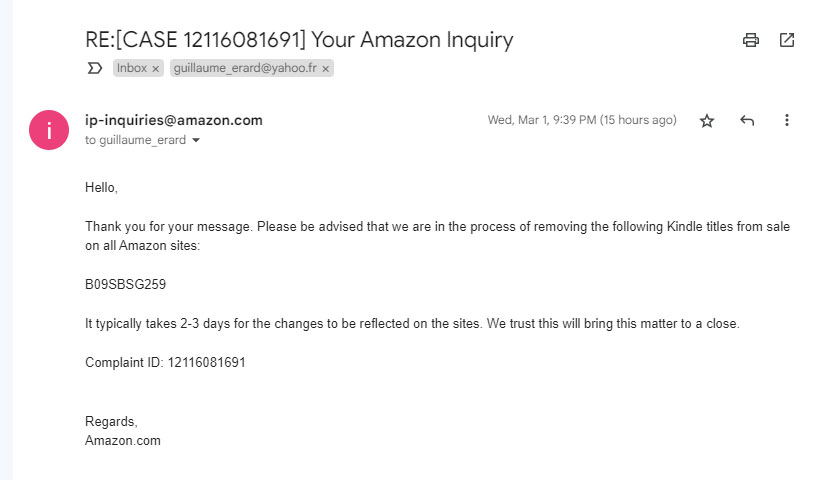 Response form Amazon following my copyright request.
Response form Amazon following my copyright request.
I will not for now take legal action to pursue my share of the income, and what is important to me is to state that my goal here is to expose what happened. I hope that the people responsible will take my objections into account and write their own texts from thereon, for the benefit of his readers. Let’s be clear, I do not encourage anyone to confront those people on social media or anywhere else. I am not attacking the individuals, but I take offense to their methods.
All I can say to you, reader, is please, do not encourage such practice by spending your money on it, especially when the content has been available for free online for ages. I do on the other hand kindly ask people who feel sympathetic towards my and others’ efforts to stay vigilant regarding the origin of the contents that they enjoy. Please purchase the books and DVDs released by the Aikikai or Aikido Journal, and consult the material that me and others produced on their original platforms.
Thank you very much for your interest and support!

